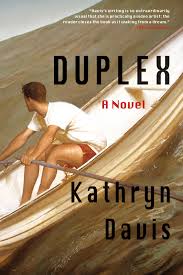What We’re Reading: Duplex

 Duplex by Kathryn Davis (Graywolf Press 2013)
Duplex by Kathryn Davis (Graywolf Press 2013)
Kathryn Davis’ newest novel (just released September 3rd!) captured me completely in its surreal tentacles of imagination and craft. According to a Q&A with Davis that I received from the publisher, the novel started as her stab at the Italian fairy tale, “Body-without-Soul.” The tale is one of the 200 folktales that Italo Calvino pulled together for his book, Italian Folktales, which seems fitting, as I was reminded of Calvino often during my reading of Duplex. There are many elements of dark fairy tales in Duplex, with Alice’s Adventures in Wonderland-esque rabbits, creepy characters such as The Sorcerer (who gathers souls in exchange for promises), and much of the murky, horrific tendencies of original folk tales.
The novel follows two young friends in love who grow up on the same street: Mary and Eddie. We follow a tangled and never-linear path of their lives, their separation, and the changes of the street on which they grew up together and fell in love. The book spans from childhood to death, with fuzzy glimpses into the past and future beyond their lives.
In addition to the fairy tale elements, the whole tone of the book is surreal. Moments bleed from normal suburban life into sci-fi robots without warning or occasion. Davis asks us to trust her, but doesn’t wait for us to answer before she’s off in the world of Duplex, and we’re left to pick out her path as we are able. It’s not for those out to find a quick and easy read, but for those of us not afraid to lose control and maybe get a little bit lost, it’s a rollicking adventure.
The dreamlike and bizarre mesh with the daily fabric of what we know of as life with what Davis refers to as “hinges,” or moments where an alternate storyline or universe takes over, or happens simultaneously. In the aforementioned Q&A, Davis talks about these as the crux of the story. Here is one such moment, when one of our main characters, Mary, discovers this hinge into an alternate space:
The lights outside brightened and went out; a car door slammed and as it did Mary felt a latch inside herself beginning to release. It was the smallest of latches but eventually she managed to force it open, not unlike the way she’d felt a million years ago letting out the baby. The chain of clouds strung around the ocean began to break into pieces. Everything was dividing into pieces to keep the parts clear. The heavens, the earth, the underworld—human beings have always needed divisions like that to know where they are and where they’re going.
In addition to hinges like the one Mary discovers, there are more metaphorical hinges: the duplex itself serves as a hinge between realities and parallel stories. While we largely follow Mary and Eddie’s lives, each of the supporting characters are also treated with the same love and attention as the main characters, thanks to a writer who creates fully dimensional characters all-around. It is Davis’ gorgeously crafted character work that holds the center of this story.
One of the most interesting characters for me is Janice, an outside narrator telling many of the folk tales that happen within the book. She’s almost a prophet — foreshadowing, warning, and keeping the history alive. An older girl who will tell stories to any of the gaggle of younger girls who follow her about, she is many things. Lonely or role model? Liar or the only truth-teller in the book? We’re introduced to Janice as such:
Generally speaking the adults on the block considered her a liar. She said her mother beat her with a willow branch and she had stripes on her back to prove it. She said humans had been right when they said the world was flat and round like a coin and you could fall of the edge. Many things everyone had been told weren’t real turned out to be real. The world had edges but you couldn’t see them going, only when you were trying to come back. Janice also said she had a brother who died of leukemia and that, amazingly enough, turned out to be true. Like everyone else, she could push buttons on a console and find out whatever she wanted to know about anybody or anything. For this reason she kept everything exceptional about herself hidden.
An un-named alternate narrator follows Janice throughout the span of the book, as they, too, get older like Mary and Eddie. Janice passes on her own folktales to the group of younger girls, as they listen with awe. Time and truth are stretched and distorted with Janice’s stories (or, rather, history lessons), that confuse and at other times reveal the true timeline and losses of this love story.
The intense attention to character and the fluid sense of timeline, sprinkled with elements of sci-fi, folktale, and mystery all add to the mesmerizing web of Duplex. What authors snare you with their fantastical imaginations? Are there writers that you think do an exceptional job of writing modern-day fairy tales?
(P.S. Davis will be reading at Magers & Quinn next Wed with Eric Lundgren. Stay tuned for an interview with Davis soon on The Writing Life!)






Comments are closed.